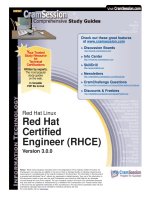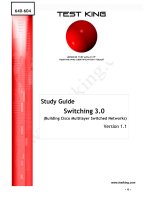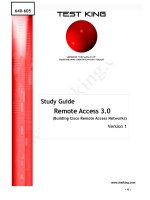Red hat certified engineer(RHCE) version 3.0.0
Bạn đang xem bản rút gọn của tài liệu. Xem và tải ngay bản đầy đủ của tài liệu tại đây (245.02 KB, 16 trang )
Red Hat Linux
Red Hat
Certified
Engineer (RHCE)
Version 3.0.0
Notice: While every precaution has been taken in the preparation of this material, neither the author nor
Cramsession.com assumes any liability in the event of loss or damage directly or indirectly caused by any
inaccuracies or incompleteness of the material contained in this document. The information in this document
is provided and distributed "as-is", without any expressed or implied warranty. Your use of the information in
this document is solely at your own risk, and Cramsession.com cannot be held liable for any damages
incurred through the use of this material. The use of product names in this work is for information purposes
only, and does not constitute an endorsement by, or affiliation with Cramsession.com. Product names used
in this work may be registered trademarks of their manufacturers. This document is protected under US and
international copyright laws and is intended for individual, personal use only.
For more details, visit our
legal page.
Check out these great features
at www.cramsession.com
> Discussion Boards
> Info Center
> SkillDrill
> Newsletters
/>> CramChallenge Questions
/>> Discounts & Freebies
/>Your Trusted
Study Resource
for
Technical
Certifications
Written by experts.
The most popular
study guides
on the web.
In Versatile
PDF file format
Red Hat Certified Engineer (RHCE)
Red Hat Linux
Red Hat Certified Engineer
(RHCE)
Version 3.0.0
Abstract:
This study guide will help you to prepare for Linux/Unix Exam RH300,
Red Hat Certified Engineer. Exam topics include Hardware and
Installation, Configuration and Administration, Kernel Services,
Networking Services, X Window System, Security, Routers, Firewalls,
Clusters and Troubleshooting. The exam has three components: Debug
(2.5 hrs), Multiple Choice (1 hr) and Server Install and Network
Services Setup (2.5 hrs.)
Find even more help here:
10/15/01
© 2001 All Rights Reserved – BrainBuzz.com
1
Red Hat Certified Engineer (RHCE)
Contents:
Contents: .......................................................... Error! Bookmark not defined.
Pre-Install..................................................................................................... 2
Installation and Troubleshooting....................................................................... 4
System Configuration ..................................................................................... 8
X Windows System......................................................................................... 9
Linux Shells and Commands / Utilities..............................................................11
Linux Shell Comparison Table.......................................................................11
Basic Linux Commands and Utilities .................................................................12
Linux Networking ..........................................................................................14
System Administration and Security ................................................................15
10/15/01
© 2001 All Rights Reserved – BrainBuzz.com
2
Red Hat Certified Engineer (RHCE)
Pre-Install
• Determine your Linux system's role in your network: WWW, FTP, NEWS, ISP,
development workstation, thin client, enterprise server, application server,
database server, etc.
Collect hardware information: check out Red Hat 5.x HCL. Be familiar with the model
and parameter of your hardware devices: keyboard, monitor (horizontal/vertical
frequencies), mouse type (serial, PS/2, or bus mouse), protocol (Microsoft, Logitech,
MouseMan, etc.), and number of buttons; printer, hard drive (IDE, EIDE, SCSI,
Cylinder/head/sector geometry), sound card, video card, PC-Card (PCMCIA) etc.
• If you have IDE drives, you should check your computer's BIOS to see if you
are accessing them in LBA mode.
• Collect network information: hostname, domain name, IP address, netmask,
default gateway, primary and secondary name server, NFS server (optional),
FTP server (optional).
• Be familiar with what packages that Red Hat comes with, so you can choose
these during installation.
• Read the Linux hardware HOWTO (in Red Hat CD:\DOC\HOWTO) to clarify the
hardware compatibility issue.
• Review IRQ settings and plan the IRQ layout. This table lists the standard IRQ
layouts:
Interrupt
Line
Device Comments
0 Timer
1 Keyboard
2
Cascade to
IRQ9
On some systems, IRQ2 is the gateway to IRQs
9~15; avoid it if possible
3 COM2 Can also be COM4, but only one of the two
4 COM1 Can also be COM3, but only one of the two
5
XT hard disk
controller,
LPT2
Hard disk interface used only on XTs, or
alternatively for LPT2 on the unusual machine
with LPT2. This is free on most modern PCs, and
is the "catch-all" IRQ for bus mice, sound cards,
LAN boards, etc.
6
Floppy disk
controller
7 LPT1
8 Clock
9
Possible
cascade to
IRQ2
May not be available
10/15/01
© 2001 All Rights Reserved – BrainBuzz.com
3
Red Hat Certified Engineer (RHCE)
10 Generally available
11 Generally available
12
Motherboard
InPort
If your PC/laptop has a built-in mouse port, it
probably sits here
13
Math
Coprocessor
This interrupt is required even if your CPU has a
numeric coprocessor built in
14 Hard Disk
15 Unused Generally available
• Hardware requirement for Red Hat 5.x installation:
Hardware
Device
Minimum Suggest Comments
Processor i386 SX without
X
i386 DX with X
P166 MMX It's hard to find a processor
older than a P166 in today's
market.
Hard Drive 60 MB 1 GB
600 MB for a complete
installation
Memory 4 MB 8 MB without X
16 MB with X
• Create installation boot disk and supplemental diskette using rawrite
program - location on CD is: \dosutils\rawrite.exe
• If Linux is to coexist with other OSs, create available hard drive space using
fips utility (a program similar to Partition Magic). Location on CD:
\dosutils\fips.exe
• Linux's primary file system is EXT2, and SWAP (for SWAP files).
• Linux supports plug and play.
Installation and Troubleshooting
• Use F3 key to go to expert mode - disables most of the auto probing and auto
detection.
• Use F4 key, and both boot and supplemental disks to repair a damaged
system.
• Use F6 key to pass some options to the kernel at the boot time. Example:
boot: linux mem=128M will instruct the kernel to use 128MB system RAM.
• Red Hat 5.x Linux Kernel file name is vmlinuz. It's on the Boot disk and is
less than 500 KB.
• initrd.img file is first loaded by system
• To install on the machine without CD-ROM: copy \RedHat\ directory tree from
CD-ROM over Network to the hard drive before install.
10/15/01
© 2001 All Rights Reserved – BrainBuzz.com
4
Red Hat Certified Engineer (RHCE)
• If IDE CD-ROM is not being detected, restart the installation process, key in
instruction to kernel: boot: linux hdX=cdrom (X=a if CD-ROM is in ide0
master; X=b if CD-ROM is in ide0 slave; X=c if CD-ROM is in ide1 master;
X=d if CD-ROM is in ide1 slave. Where ide0=primary channel and
ide1=secondary channel).
• Partition disk using Disk Druid during installation. Know what is the Mount
Point, Device, Requested, Actual, Type, and how to specify the particular
parameter for them. Know Driver summary, especially what Geom [C/H/S]
means. (Cylinders, Heads, Sectors).
• / and swap are default partitions to specify when using Disk Druid.
• Partition disk using fdisk during installation. Be familiar with following
commands and their usages:
Command Usage
m display help menu
p list current partition table
t change system partition ID
n add new partition
d delete current partition
l list known partition types
q quit without saving changes
w write changes and quit
• Linux partitions - It's recommended to create multiple partitions for Linux
instead of using a single partition.
Partition
Name
Comment
swap (82)
Swap partitions are used to support virtual memory. If the
system has 16 MB of RAM or less, you must create a swap
partition. Even if you have more RAM, swap is still necessary.
The minimum size of a swap partition should be equal to your
physical RAM, or 16 MB (whichever is larger). Red Hat
recommends 32 MB for workstation installation and 64 for server
installation
root (83)
Root partition is where the root directory resides. It only needs
to contain things necessary to boot your system, as well as
system configuration files. 50~80 MB works well for most
systems
/usr
This is where most software on Linux systems resides. This
partition should be between 200~500 MB, depending on how
man
y packages you plan to install. Any RPM-based package you
10/15/01
© 2001 All Rights Reserved – BrainBuzz.com
5









